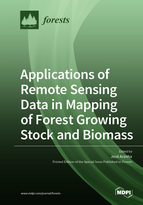Applications of Remote Sensing Data in Mapping of Forest Growing Stock and Biomass
A special issue of Forests (ISSN 1999-4907). This special issue belongs to the section "Forest Inventory, Modeling and Remote Sensing".
Deadline for manuscript submissions: closed (31 March 2020) | Viewed by 43775
Special Issue Editor
Interests: forestry; biomass; land cover dynamics; spatial analysis; wild fires; ecosystem services
Special Issues, Collections and Topics in MDPI journals
Special Issue Information
Dear Colleagues,
Forested areas and stock biomass are of interest in a climatic change scenario and increasing carbon emission. Forest canopy plays an important role in ecosystem services that can provide soil protecting against erosion, a water management cycle, biomass production, and carbon stock.
Regular forested area surveys for biophysical measurements and inventory are time-consuming and very expensive. Thus, remote sensing can be a very important and useful tool in the cartography of the forested areas along the past, in canopy changes analysis and in biophysical variables modeling, such as canopy density, basal area growing, and biomass stocking. Based on satellite image bands, it is possible to derive vegetation indices and allometric models to estimate forest cover characteristics and variations in the amount of biomass.
At present, several spatial agencies provide regular and free satellite images with high quality and resolution across almost all continents and countries. Due to improvements in technology that are followed by price reduction, local imagery capture is increasingly accessible to researchers, giving them autonomy to develop and share a wide variety of projects.
We would like to invite you to contribute with your work for the Special Issue: Applications of Remote Sensing Data in Mapping of Forest Growing Stock and Biomass.
Dr. José Aranha
Guest Editor
Manuscript Submission Information
Manuscripts should be submitted online at www.mdpi.com by registering and logging in to this website. Once you are registered, click here to go to the submission form. Manuscripts can be submitted until the deadline. All submissions that pass pre-check are peer-reviewed. Accepted papers will be published continuously in the journal (as soon as accepted) and will be listed together on the special issue website. Research articles, review articles as well as short communications are invited. For planned papers, a title and short abstract (about 100 words) can be sent to the Editorial Office for announcement on this website.
Submitted manuscripts should not have been published previously, nor be under consideration for publication elsewhere (except conference proceedings papers). All manuscripts are thoroughly refereed through a single-blind peer-review process. A guide for authors and other relevant information for submission of manuscripts is available on the Instructions for Authors page. Forests is an international peer-reviewed open access monthly journal published by MDPI.
Please visit the Instructions for Authors page before submitting a manuscript. The Article Processing Charge (APC) for publication in this open access journal is 2600 CHF (Swiss Francs). Submitted papers should be well formatted and use good English. Authors may use MDPI's English editing service prior to publication or during author revisions.
Keywords
- Remote sensing applications in forested areas analysis: Land use and land cover changes classification and quantification
- Forested areas composition and dynamics along the last decades
- Vegetation indices calculation and allometric equations adjustment for forest canopy changes analysis and biophysical variable modeling
- Landscape dynamic analysis by means of image processing techniques: Deforestation and post-disturbance (e.g., fire or harvesting) recovery
- Biomass growing and carbon stock dynamic analysis
- Forest inventory and management






